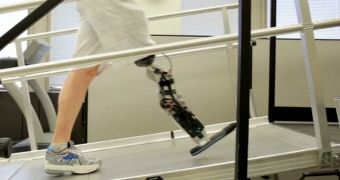We've seen plenty of prosthetic arms and legs, enough to almost forget that there were times when people used peg legs, but the most advanced one yet might have just been unveiled.
Scientists and doctors from the Rehabilitation Institute of Chicago have outfitted a 32-year-old man with a robotic prosthesis that is controlled by thought.
The man lost his leg below the knee in a motorcycle accident four years ago and couldn't have expected to regain so much of his ability to walk, at any point.
We've actually seen mind-controlled bionic arms in the past, but this is the first leg that operates on a similar principle.
How does it work? It decodes electrical signals that travel through Zac Vawter's remaining leg muscle, this interpreting intended movements.
Motors integrated into the knee and ankle provide the needed mobility and force to go up stairs or perform other activities normally too complex for regular prosthetic limbs.
All in all, compared to passive lower-leg prosthetics, which act like a spring, the new bionic leg will feel much closer to an actual limb.
“[The leg] responds much more appropriately to the environment, and where I want to go, and how I want to walk,” Vawter said, pointing out that with normal prosthetics he'd have to use the same lag (his good one) to climb every stair.
“Whereas with this leg, it's more so that I just interact with my environment how a normal person would [and can walk up stairs foot over foot].”
Here's how it all works: the researchers first performed a surgery on Vawter, to redirect the nerve signals from where his leg was amputated. Where they once went to the lower leg, they were led to the healthy hamstring muscle in the top part of his leg instead.
Electrodes were then placed on the leg, to detect those signals. Then a computer program decoded the signals and added to the data collected by mechanical sensors on the robotic leg (including an accelerometer and a gyroscope). In the end, the error rate was of 1.8%, unlike the 12.9% provided by only the mechanical sensors.

 14 DAY TRIAL //
14 DAY TRIAL //